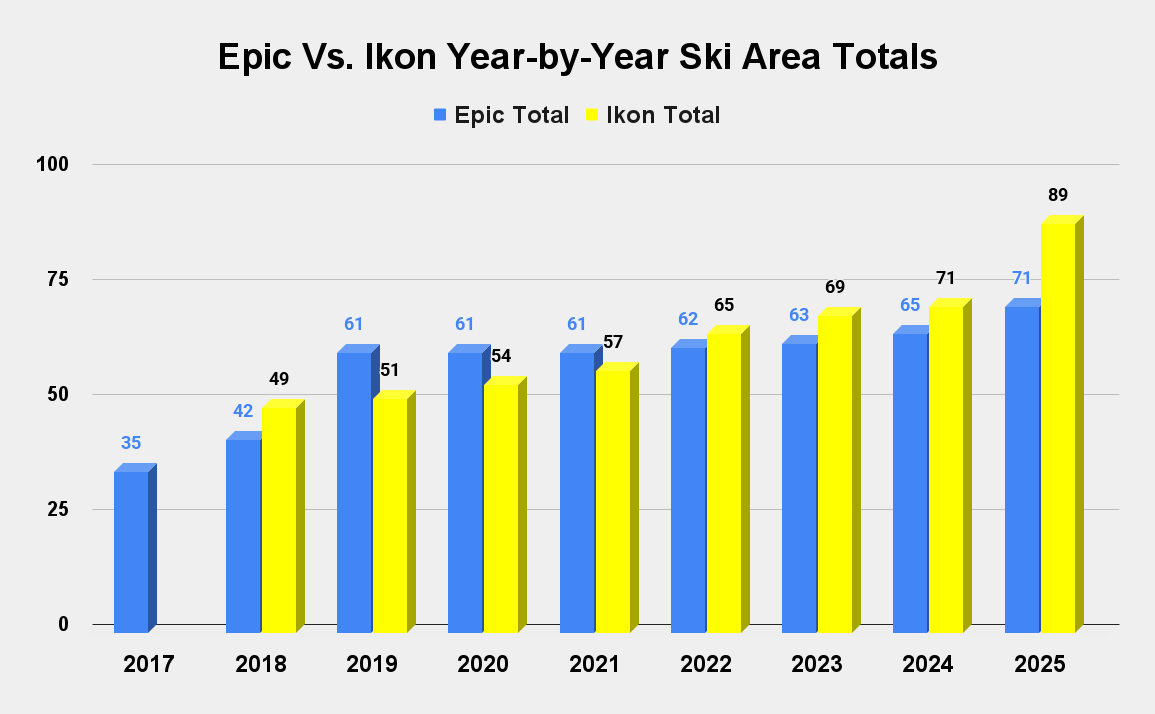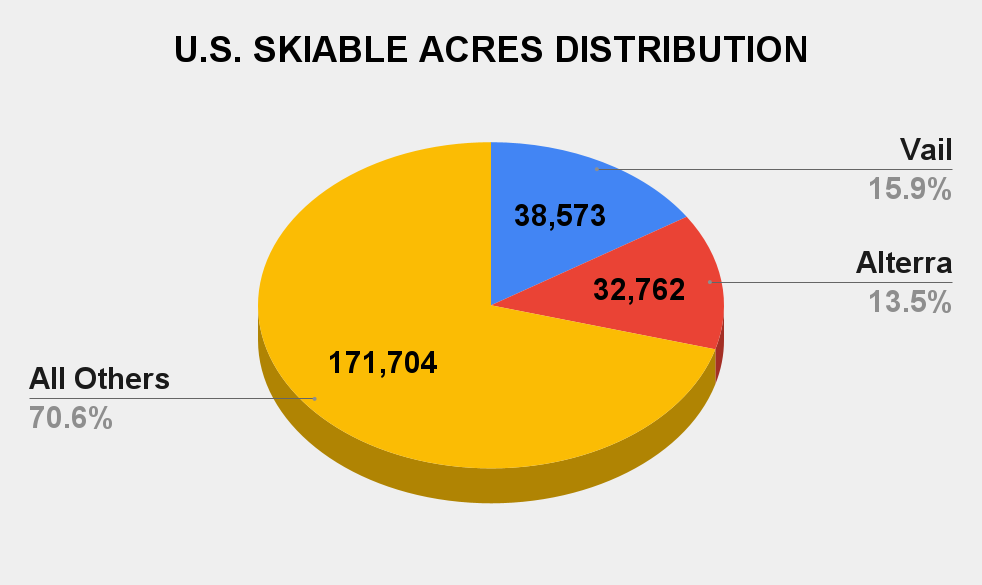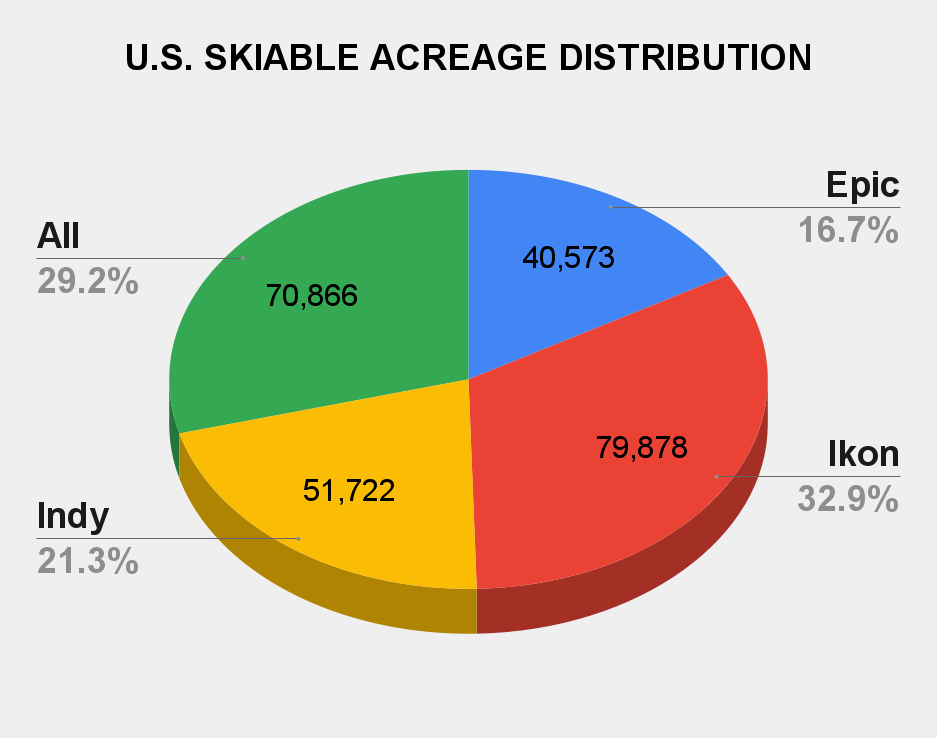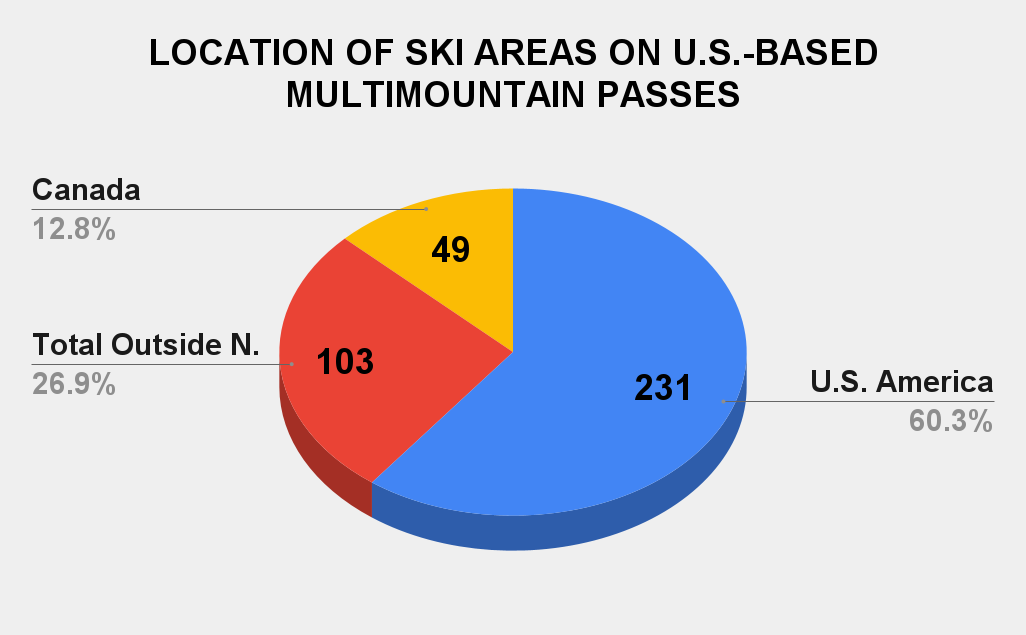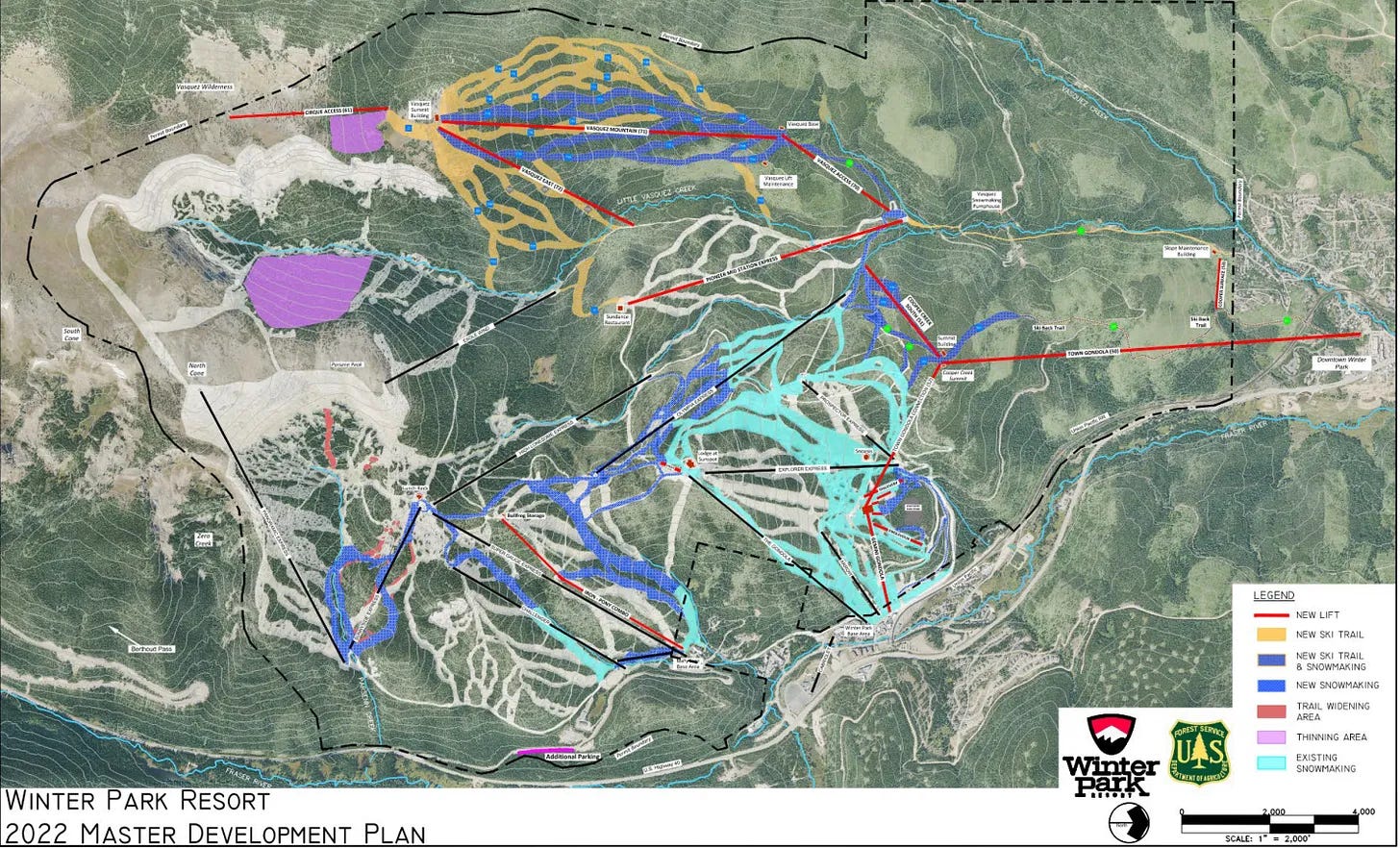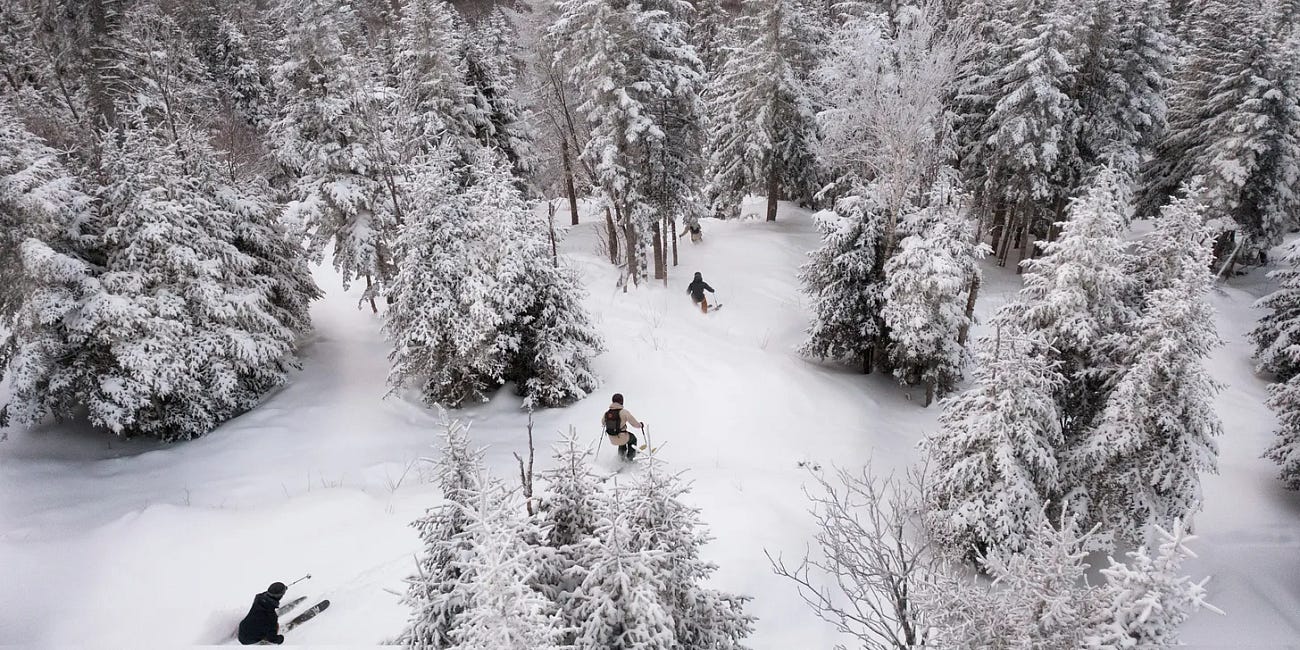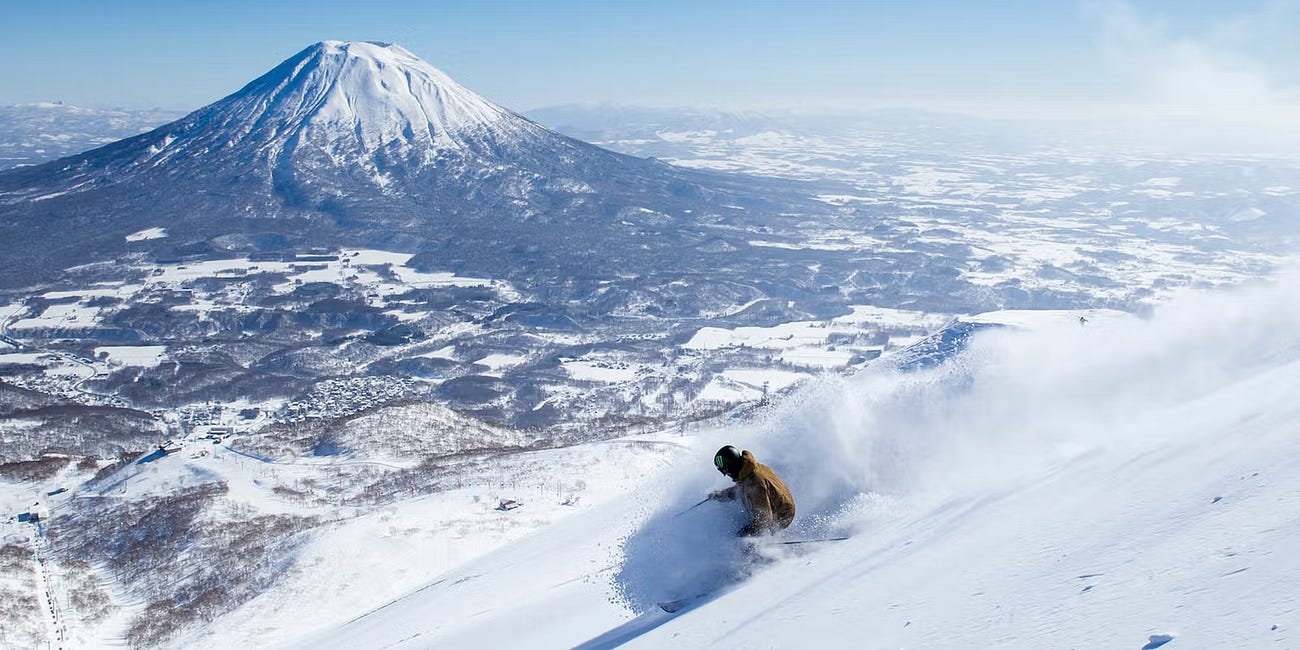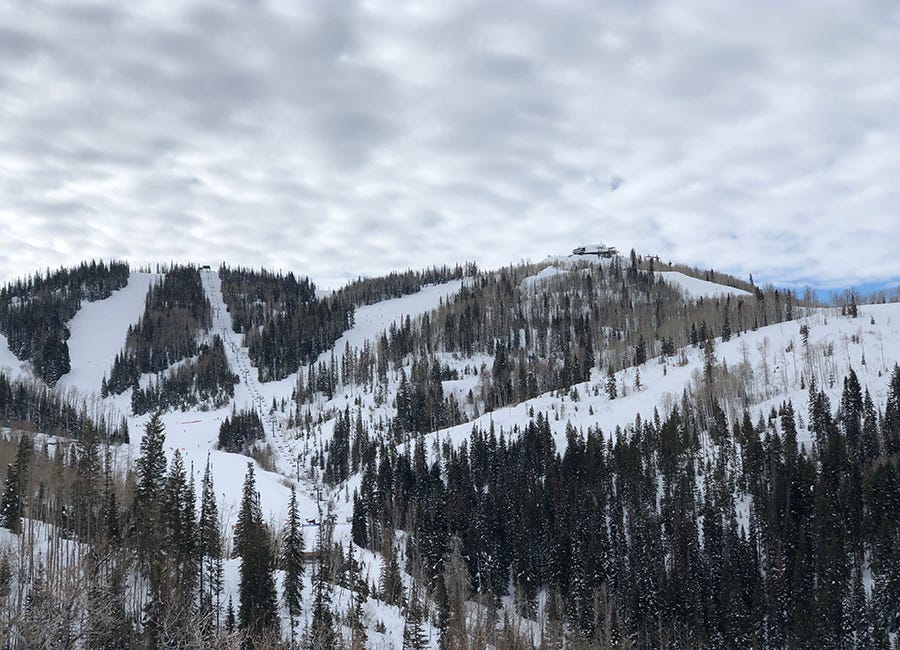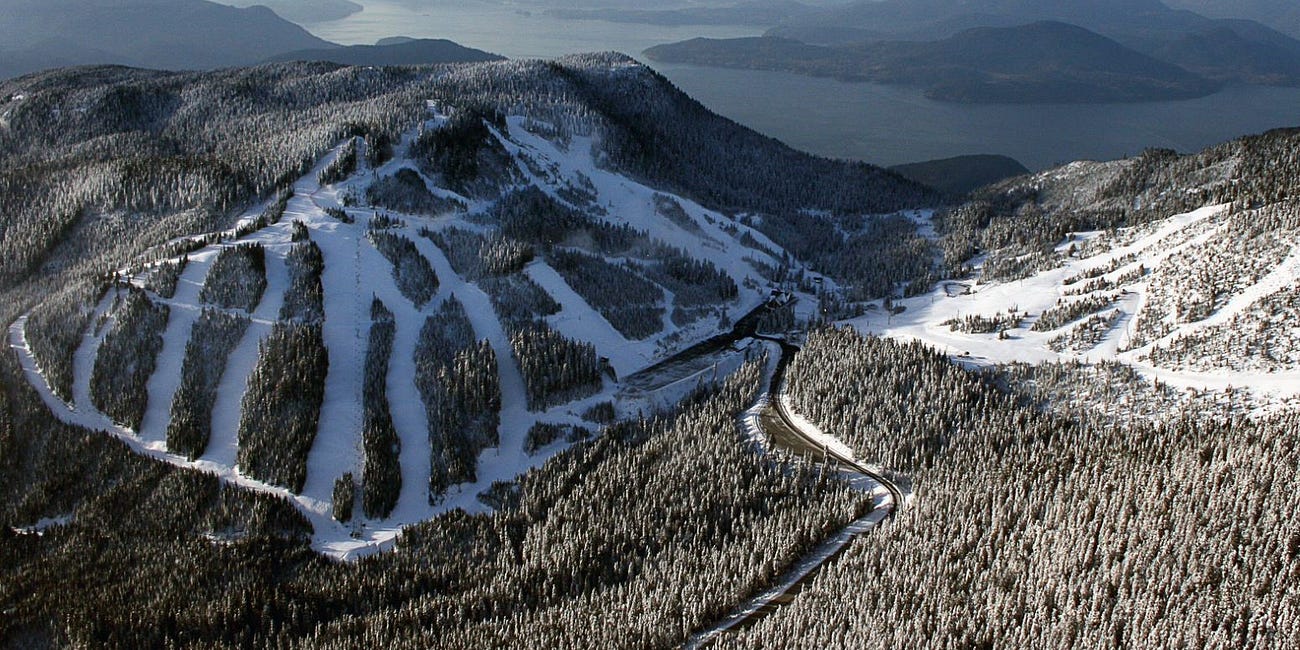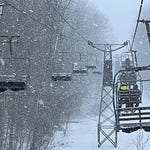Who
Jared Smith, Chief Executive Officer of Alterra Mountain Company
Recorded on
October 22, 2025
About Alterra Mountain Company
Alterra is skiing’s Voltron, a collection of super-bots united to form one super-duper bot. Only instead of gigantic robot lions the bots are gigantic ski areas and instead of fighting the evil King Zarkon they combined to battle Vail Resorts and its cackling mad Epic Pass. Here is Alterra’s current ski-bot stable:
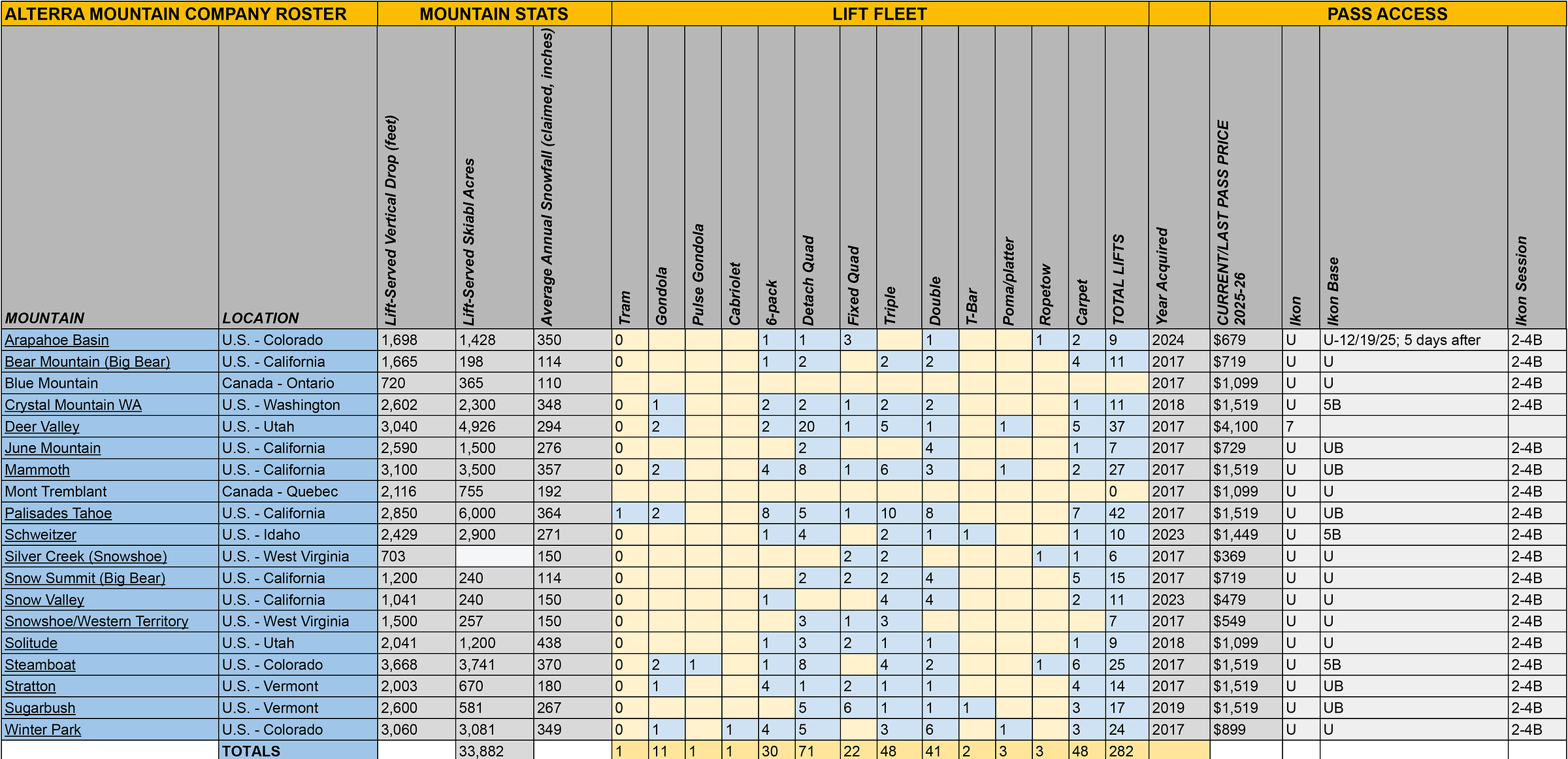
Alterra of course also owns the Ikon Pass, which for the 2025-26 winter gives skiers all of this:
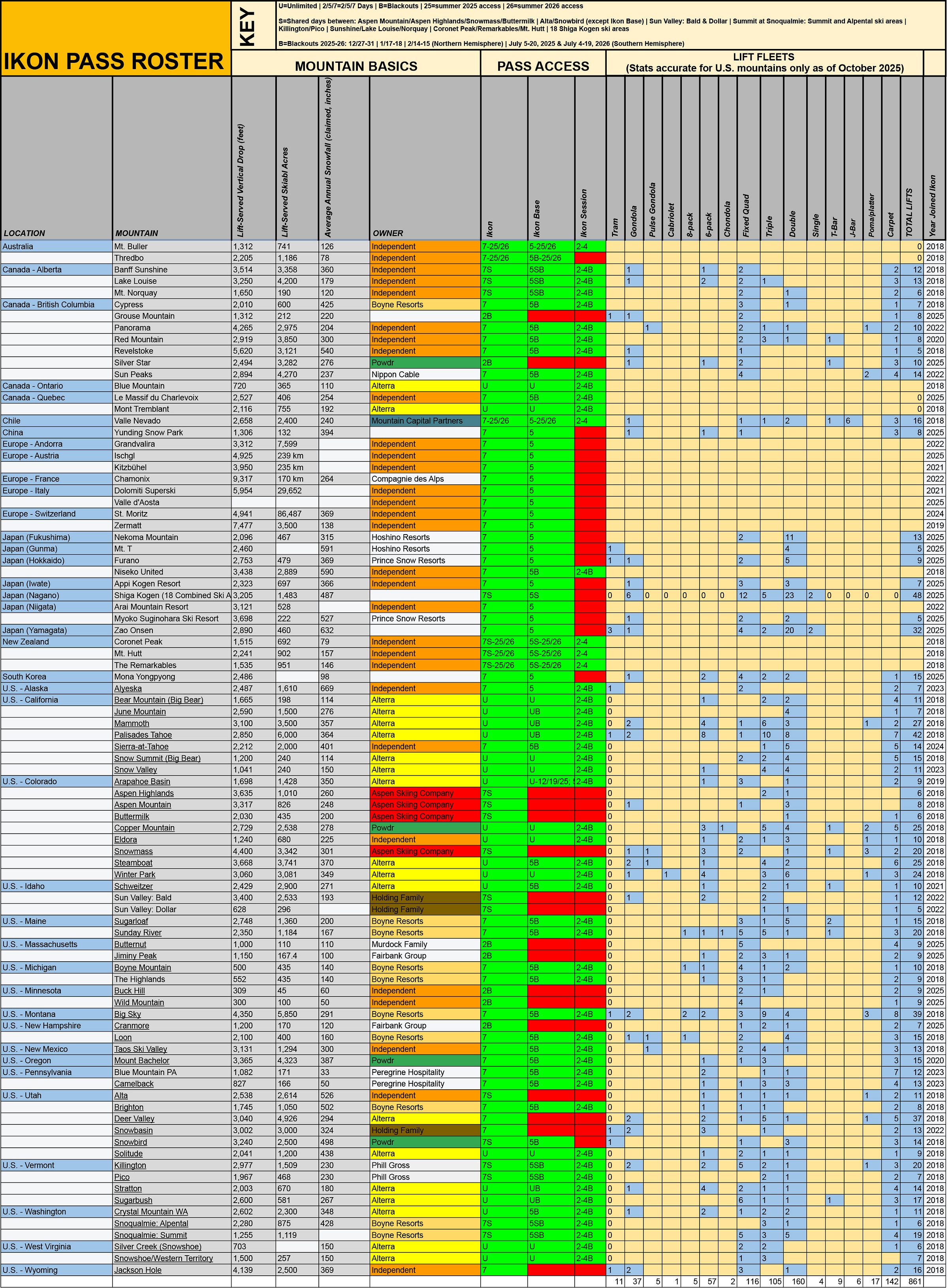
Ikon launched in 2018 as a more-or-less-even competitor to Epic Pass, both in number and stature of ski areas and price, but long ago blew past its mass-market competitor in both:
Those 89 total ski areas include nine that Alterra added last week in Japan, South Korea, and China. Some of these 89 partners, however, are so-called “bonus mountains,” which are Alterra’s Cinderellas. And not Cinderella at the end of the story when she rules the kingdom and dines on stag and hunts peasants for sport but first-scene Cinderella when she lives in a windowless tower and wears a burlap dress and her only friends are talking mice. Meaning skiers can use their Ikon Pass to ski at these places but they are not I repeat NOT on the Ikon Pass so don’t you dare say they are (they are).
Why Did Ikon Pass Add 2 Days at Jiminy Peak, Cranmore, Buck Hill, and Wild Mountain?
Ikon dropped the news like a legal disclosure, tucked into page 34 of the 2025-26-Ikon-Pass-is-live press release. Tucked into the “passholder discounts and benefits” section, between the free-donut-if-it-snows-six-inches-the-day-of-your-visit coupon and the five percent discount at Food Truck Freddy’s Fenomenally Fantastic & Awesome French Fries* was this tidbit: full Ikon Pass holders would receive two days each at four new U.S. ski areas next season.
Silver Star, Grouse Mountain in B.C. & Butternut, Mass. Join Ikon Pass 2-Day Tier
Hi! Nice to see you. Where have I been, you ask? Well, Friend, I’ve been fighting to the death with my old pal Covid for the past eight or nine days. So far I’m winning, but it’s keeping me from doing other things, like my job. Sorry about that. Have a pleasant day and wish me luck with this whole not-dying thing. Talk soon. Peace and Taco Bell to you and yours. Sincerely, Stu.
While the Ikon Pass is Alterra’s Excalibur, many of its owned mountains offer their own season passes (see Alterra chart above). And many now offer their own SUPER-DUPER season passes that let skiers do things like cut in front of the poors and dine on stag in private lounges:

These SUPER-DUPER passes don’t bother me though a lot of you want me to say they’re THE END OF SKIING. I won’t put a lot of effort into talking you off that point so long as you’re all skiing for $17 per day on your Ikon Passes. But I will continue to puzzle over why the Ikon Session Pass is such a very very bad and terrible product compared to every other day pass including those sold by Alterra’s own mountains. I am also not a big advocate for peak-day lift ticket prices that resemble those of black-market hand sanitizer in March 2020:
Fortunately Vail and Alterra seem to have launched a lift ticket price war, the first battle of which is The Battle of Give Half Off Coupons to Your Dumb Friends Who Don’t Buy A Ski Pass 10 Months Before They Plan to Ski:
An Epic Pass Friend Ticket That Won’t Make Your Friends Hate You
Couches are the worst. Expensive, awkward, heavy. Always either too big or too small, too stiff or too soft, too formal or too thrown-out-the-window-during-a-housefire trashed. A couch is at once necessary and almost impossible to buy – the last three couch salesman I engaged with presented the intelligence of a broomstick dressed in a collared shirt and khakis. I retreated to the internet, a head-on collision with the fact that couch designers’ aspirational lounging dimensions often far exceed those of doorway, stairwell, and elevator designers – I had to saw the new couch in half to move it up to the apartment. A couch is the biggest thing in most homes but also the most fragile: a housecat can reduce a $5,000 couch to kite string in under 90 seconds. Couches stain and tear like printer paper but cannot be repaired for less than the cost of the couch itself. “Crashing on the couch” is one of our most heroic cultural memes, but also part fiction – ask anyone 6’2” (me) how much those two inches matter when attempting to “crash” on the standard six-foot-long couch. People do unspeakable things on couches. But also lots of speakable ones and the under-cushion and under-couch catacombs time-capsule lost food and change and pocketstuff. Yet we almost never clean these sedentary lifestyle chariots. And after 15 years and seven apartments and three cats who used it as an occasional litterbox, you list the couch for $300 on Facebook Marketplace. Five people say they’ll take it but only one shows up and he's driving a motorcycle and can’t believe the couch won’t fit on his luggage rack and offers you $10 if you’ll let him come by later with his buddy’s Corolla. This is why you never want to own a couch but also why you never want to own a pickup truck.
Ikon Hits Back at Epic With 50% Off Buddy Tickets; Includes Deer Valley, Steamboat
Well the ski-day cost calculus isn’t getting any less confusing.
Alterra also runs some heli-ski outfits up in B.C. but I’m not going to bother decoding all that because one reason I started The Storm was because I was over stories of Bros skiing 45 feet of powder at the top of the Chugach while the rest of us fretted over parking reservations and the $5 replacement cost of an RFID card. I know some of you are like Bro how many stories do you think the world needs about chairlifts but hey at least pretty much anyone reading this can go ride them.
Oh and also I probably lost like 95 percent of you with Voltron because unless you were between the ages of 7 and 8 in the mid-1980s you probably missed this:
One neat thing about skiing is that if someone ran headfirst into a snowgun in 1985 and spent four decades in a coma and woke up tomorrow they’d still know pretty much all the ski areas even if they were confused about what’s a Palisades Tahoe and why all of us future wussies wear helmets. “Damn it, Son in my day we didn’t bother and I’m just fine. Now grab $20 and a pack of smokes and let’s go skiing.”
Why I interviewed him
For pretty much the same reason I interviewed this fellow:
I mean like it or not these two companies dominate modern lift-served skiing in this country, at least from a narrative point of view. And while I do everything I can to demonstrate that between the Indy Pass and ski areas not in Colorado or Utah or Tahoe plenty of skier choice remains, it’s impossible to ignore the fact that Alterra’s 17 U.S. ski areas and Vail’s 36 together make up around 30 percent of the skiable terrain across America’s 509 active ski areas:
And man when you add in all U.S. Epic and Ikon mountains it’s like dang:
We know publicly traded Vail’s Epic Pass sales numbers and we know those numbers have softened over the past couple of years, but we don’t have similar access to Alterra’s numbers. A source with direct knowledge of Ikon Pass sales recently told me that unit sales had increased every year. Perhaps some day someone will anonymously message me a screenshot code-named Alterra’s Big Dumb Chart documenting unit and dollar sales since Ikon’s 2018 launch. In the meantime, I’m just going to have to keep talking to the guy running the company and asking extremely sly questions like, “if you had to give us a ballpark estimate of exactly how many Ikon Passes you sold and how much you paid each partner mountain and which ski area you’re going to buy next, what would you say?”
What we talked about
A first-to-open competition between A-Basin and Winter Park (A-Basin won); the allure of skiing Japan; Ikon as first-to-market in South Korea and China; continued Ikon expansion in Europe; who’s buying Ikon?; bonus mountains; half-off friends tickets; reserve passes; “one of the things we’ve struggled with as an industry are the dynamics between purchasing a pass and the daily lift ticket price”; “we’ve got to find ways to make it more accessible, more affordable, more often for more people”; Europe as a cheaper ski alternative to the West; “we are focused every day on … what is the right price for the right consumer on the right day?”; “there’s never been more innovation” in the ski ticket space; Palisades Tahoe’s 14-year-village-expansion approval saga; America’s “increasingly complex” landscape of community stakeholders; and Deer Valley’s massive expansion.
What I got wrong
We didn’t get this wrong, but when we recorded this pod on Wednesday, Smith and I discussed which of Alterra’s ski areas would open first. Arapahoe Basin won that fight, opening today (Sunday, Oct. 26).
I said that 40 percent of all Epic, Ikon, and Indy pass partners were outside of North America. This is inaccurate: 40 percent (152) of those three passes’ combined 383 partners is outside the United States. Subtracting their 49 Canadian ski areas gives us 103 mountains outside of North America, or 27 percent of the total.
I claimed that a ski vacation to Europe is “a quarter of the price” of a similar trip to the U.S. This was hyperbole, and obviously the available price range of ski vacations is enormous, but in general, prices for everything from lift tickets to hotels to food tend to be lower in the Alps than in the Rocky Mountain core.
It probably seems strange that I said that Deer Valley’s East Village was great because you could drive there from the airport without hitting a spotlight and also said that the resort would be less car-dependent. What I meant by that was that once you arrive at East Village, it is – or will be, when complete – a better slopeside pedestrian village experience than the car-oriented Snow Park that has long served as the resort’s principal entry point. Snow Park itself is scheduled to evolve from parking-lot-and-nothing-else to secondary pedestrian village. The final version of Deer Valley should reduce the number of cars within Park City proper and create a more vibrant atmosphere at the ski area.
Questions I wish I’d asked
The first question you’re probably asking is “Bro why is this so short aren’t your podcasts usually longer than a Superfund cleanup?” Well I take what I can get and if there’s a question you can think of related to Ikon or Alterra or any of the company’s mountains, it was on my list. But Smith had either 30 minutes or zero minutes so I took the win.
Podcast Notes
On Deer Valley
I was talking to the Deer Valley folks the other day and we agreed that they’re doing so much so fast that it’s almost impossible to tell the story. I mean this was Deer Valley two winters ago:
And this will be Deer Valley this winter:
Somehow it’s easier to write 3,000 words on Indy Pass adding a couple of Northeast backwaters than it is to frame up the ambitions of a Utah ski area expanding by as much skiable acreage as all 30 New Hampshire ski areas combined in just two years. Anyway Deer Valley is about to be the sixth-largest ski area in America and when this whole project is done in a few years it will be number four at 5,700 acres, behind only Vail Resorts’ neighboring Park City (7,300 acres), Alterra’s own Palisades Tahoe (6,000 acres), and Boyne Resorts’ Big Sky (5,850 acres).
On recent Steamboat upgrades
Yes the Wild Blue Gondola is cool and I’m sure everyone from Baton-Tucky just loves it. But everything I’m hearing out of Steamboat over the past couple of winters indicates that A) the 650-acre Mahogany Ridge expansion adds a fistfighting dimension to what had largely been an intermediate ski resort, and that, B) so far, no one goes over there, partially because they don’t know about it and partially because the resort only cut one trail in the whole amazing zone (far looker’s left):
I guess just go ski this one while everyone else still thinks Steamboat is nothing but gondolas and Sunshine Peak.
On Winter Park being “on deck”
After stringing the two sides of Palisades Tahoe together with a $75 trillion gondola and expanding Steamboat and nearly tripling the size of Deer Valley, all signs point to Alterra next pushing its resources into actualizing Winter Park’s ambitious masterplan, starting with the gondola connection to town (right side of map):
On new Ikon Pass partners for 2025-26
You can read about the bonus partners above, but here are the write-ups on Ikon’s full seven/five-day partners:
Ikon Pass Adds 7 Ski Areas in Japan, 1 Each in China, South Korea
Alterra just dropped the largest bucket of new Ikon Pass partners since the product’s 2018 debut, adding nine new ski resorts for the 2025-26 ski season. Seven are in Japan, and include four of the 10-largest ski areas in the snowy nation. The other two include Yunding Snow Park in China and Mona Yongpyong in South Korea – the first ski areas from each of those nations to join any U.S.-based multimountain pass:
On previous Alterra podcasts
This was Smith’s second appearance on the pod. Here’s number one, from 2023:
His predecessor, Rusty Gregory, appeared on the show three times:
I’ve also hosted the leaders of a bunch of Alterra leaders on the pod, most recently A-Basin and Mammoth:
And the heads of many Ikon Pass partners – most recently Killington and Sun Valley:
On U.S. passes in Japan
Epic, Ikon, Indy, and Mountain Collective are now aligned with 48 ski areas in Japan – nearly as many as the four passes have signed in Canada:

On Europe
And here are the European ski areas aligned with Epic, Ikon, Indy, and Mountain Collective – the list is shorter than the Japanese list, but since each European ski area is made up of between one and 345 ski areas, the actual skiable acreage here is likely equal to the landmass of Greenland:

On skier and ski area growth in China
China’s ski industry appears to be developing rapidly - I’m not sure what to make of the difference between “ski resorts” and “ski resorts with aerial ropeways.” Normally I’d assume that means with or without lifts, but that doesn’t make a lot of sense and sometimes nations frame things in very different ways.
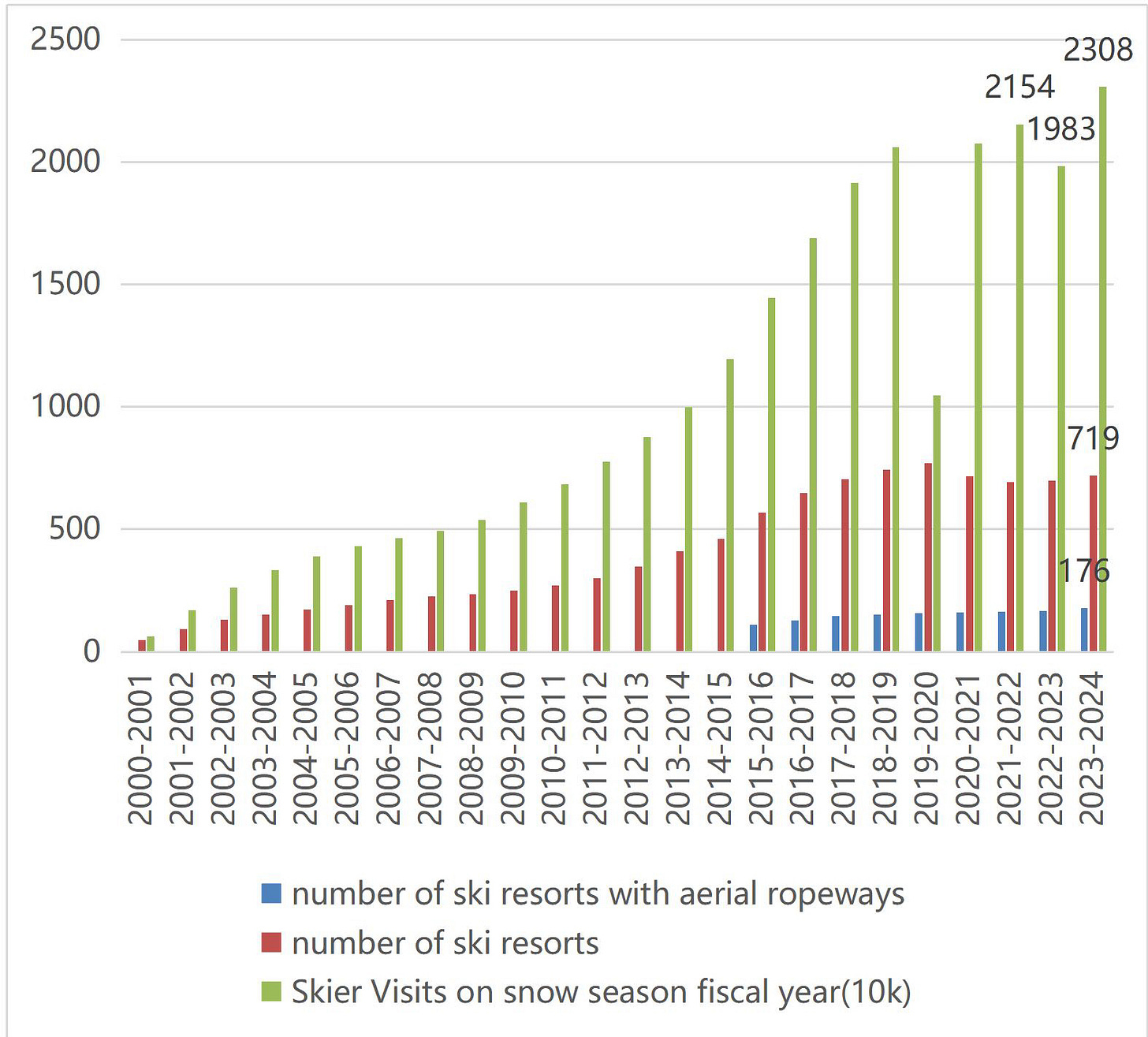
On the village at Palisades Tahoe
The approval process for a village expansion on the Olympic side of Palisades Tahoe was a very convoluted one. KCRA sums the outcome up well (I’ll note that “Alterra” did not call for anything in 2011, as the company didn’t exist until 2017):
Under the initial 2011 application, Alterra had called for the construction of 2,184 bedrooms. That was reduced to 1,493 bedrooms in a 2014 revised proposal where 850 housing units — a mix of condominiums, hotel rooms and timeshares — were planned. The new agreement calls for a total of 896 bedrooms.
The groups that pushed this downsizing were primarily Keep Tahoe Blue and Sierra Watch. Smith is very diplomatic in discussing this project on the podcast, pointing to the “collaboration, communication, and a little bit of compromise” that led to the final agreement.
I’m not going to be so diplomatic. Fighting dense, pedestrian-oriented development that could help reconfigure traffic patterns and housing availability in a region that is choking on ski traffic and drowning in housing costs is dumb. The systems for planning, approving, and building anything that is different from what already exists in this nation are profoundly broken. The primary issue is this: these anti-development crusaders position themselves as environmental defenders without acknowledging (or, more likely, realizing), that the existing traffic, blight, and high costs driving their resistance is a legacy of haphazard development in past decades, and that more thoughtful, human-centric projects could mitigate, rather than worsen, these concerns. The only thing an oppose-everything stance achieves is to push development farther out into the hinterlands, exacerbating sprawl and traffic.
British Columbia is way ahead of us here. I’ve written about this extensively in the past, and won’t belabor the point here except to cite what I wrote last year about the 3,711-home city sprouting from raw wilderness below Cypress Mountain, a Boyne-owned Ikon Pass partner just north of Vancouver:
Mountain town housing is most often framed as an intractable problem, ingrown and malignant and impossible to reset or rethink or repair. Too hard to do. But it is not hard to do. It is the easiest thing in the world. To provide more housing, municipalities must allow developers to build more housing, and make them do it in a way that is dense and walkable, that is mixed with commerce, that gives people as many ways to move around without a car as possible.
This is not some new or brilliant idea. This is simply how humans built villages for about 10,000 years, until the advent of the automobile. Then we started building our spaces for machines instead of for people. This was a mistake, and is the root problem of every mountain town housing crisis in North America. That and the fact that U.S. Americans make no distinction between the hyper-thoughtful new urbanist impulses described here and the sprawling shitpile of random buildings that are largely the backdrop of our national life. The very thing that would inject humanity into the mountains is recast as a corrupting force that would destroy a community’s already-compromised-by-bad-design character.
Not that it will matter to our impossible American brains, but Canada is about to show us how to do this. Over the next 25 years, a pocket of raw forest hard against Cypress’ access road will sprout a city of 3,711 homes that will house thousands of people. It will be a human-scaled, pedestrian-first community, a city neighborhood dropped onto a mountainside. A gondola could connect the complex to Cypress’ lifts thousands of feet up the mountain – more cars off the road. It would look like this (the potential aerial lift is not depicted here):
Here’s how the whole thing would set up against the mountain:
And here’s what it would be like at ground level:
Like wow that actually resembles something that is not toxic to the human soul. But to a certain sort of Mother Earth evangelist, the mere suggestion of any sort of mountainside development is blasphemous. I understand this impulse, but I believe that it is misdirected, a too-late reflex against the subdivision-off-an-exit-ramp Build-A-Bungalow mentality that transformed this country into a car-first sprawlscape. I believe a reset is in order: to preserve large tracts of wilderness, we should intensely develop small pieces of land, and leave the rest alone. This is about to happen near Cypress. We should pay attention.
Given the environmental community’s reflexive and vociferous opposition to a recent proposal to repurpose tracts of not-necessarily-majestic wilderness for housing, I’m not optimistic that we possess the cultural brainpower to improve our own lives through policy. Which is why I’ve been writing more about passes and less about our collective ambitions to make everything from the base of the lifts outward as inconvenient and expensive as possible.
Podcast #180: Cypress Mountain President & General Manager Matt Davies
This podcast hit paid subscribers’ inboxes on Sept. 11. It dropped for free subscribers on Sept. 19. To receive future pods as soon as they’re live, and to support independent ski journalism, please consider an upgrade to a paid subscription. You can also subscribe to the free tier below:





